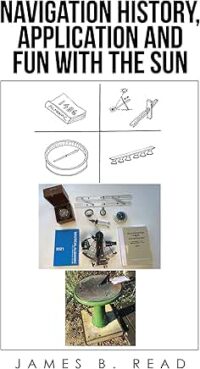Title: Navigation History, Application and Fun with the Sun
Author: James B. Read
Publisher: iUniverse
ISBN: 978-1663247360
Pages: 88
Genre: Navigation History / Non-Fiction
Reviewer: Subhrajit Saha
Hollywood Book Reviews
There was a time when the world believed that the sun revolved around the earth, until the Renaissance brought a wave of transformation, and Nicolaus Copernicus forever changed the most basic concept of science, opening a brand-new door to innovation that propelled human civilization forward. A couple of hundred years ago, it was thought that only birds and inert matter could fly in the sky until the Wright brothers completely changed the dimension of soaring high above. Just a few decades ago, the idea of connecting with people in a matter of seconds was a daydream, and now we can reach our near and dear ones in the blink of an eye. In the journey of innovation, people have imagined endlessly – some dismissed it as rubbish, while others turned fascinating thoughts into reality, just as Vasco da Gama did six hundred years ago. The more time passes, the more we marvel at how they managed to sail across the seas and uncover a completely new world, which until then had been nothing more than a myth. Author James B. Read’s brilliant exploration of the history of navigation, blending facts and historical elements with precise equations and theories, is as astonishing as when we first heard of the discoveries of Christopher Columbus or da Gama.
The expedition of the book begins with the author taking us back to the early days when it took five years to determine the latitude of a single place. The timeline of the exploration of navigation starts in the fourteenth century, during the era of Henrique Infante, the King of Portugal. The author transforms his experience and history into words through a compelling blend of narrative, mentioning navigation instruments that shaped the course of time. He gives a flashback to the fascinating history of early navigation, highlighting tools like the Medieval Stopwatch, detailing the process of time measurement, wind speed data collection, measuring the longitude, its purpose and goal in aiding navigation. The author vividly illustrates these advancements with the help of intriguing equations, evoking a sense of awe about how the invention of finding latitude at sea revolutionized navigation. This breakthrough opened a completely new dimension to the world, paving the way for the timeless journeys of sailors and inventors. The world soon witnessed legendary expeditions, including Bartolomeu Dias in 1488, Christopher Columbus in 1492, Vasco da Gama in 1496, and many more, each adding to the legacy of exploration.
In the later journey of Navigation History, Application and Fun with the Sun, the engaging relationship between one’s latitude and the equator, and the intricate connection of longitude between meridians and latitude, make James B. Read’s narrative even more enriching. As the book progresses, it feels like an epic that traverses blocks of time, enriched with quality mathematical equations about noon sight, GPS programs, time angles, the interplay of time zones, hemispheres, and more.
In the end, it must be said that if you are seeking a timeless journey, are an attentive student of science, and have a keen interest in the history of navigation and its evolution through the centuries, this is a highly recommended read. As information packed as it is, the narrative remains engaging, supported by numerous illustrations that perfectly complement the facts, breaking the monotony of the various methods, numbers, and technical points of navigation.
This book both educates and inspires, and it rekindles a sense of wonder for the natural world and reminds us of the incredible tools we have in the sky above. I highly recommend Navigation History, Application and Fun with the Sun to anyone who loves to learn while having fun.

